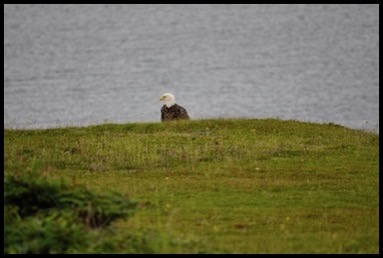Cape Breton Island, Day One
Today started off early with a 7 a.m. departure to Cape Breton Island. Our goal was to make the 11:30 a.m. Cailidh in Judique at the Celtic Music Cultural Centre. Both of us love Celtic music and have many albums. This area is the birthplace of Natalie MacMaster, Ashley MacIsaac, and the Rankins for just a small number.
We made the Cailidh with a little time to spare. “Failte” (fell-cha) greets us as we enter. “Failte” is “Welcome” in Gaelic. The Director of the Centre is Kinnon Beaton and he will play the fiddle for about one hour over the lunch period. We listen to music while eating a lovely seafood chowder full of scallops, crab, and lobster which is then topped off with a bread pudding with caramel sauce. The music is toe-tapping wonderful and we got some video of the different songs played. Here is Kinnon Beaton with Dewars playing piano. We even had an example of “Close to the Ground” Cape Breton step dancing.

They have an exhibit area at the Centre where one can learn about jigs, reels, slow airs, and Strathspeys. They even have video to show you how to play a few notes of the fiddle and to do step dancing too.
We headed on further up the left coast of Cape Breton to our destination of St. Joseph du Moine, just south of Cheticamp. Our B and B is the Pilot Whale at St. Joseph. Not far from there, Bob saw a Bald Eagle just off the road and he was able to get a few photos of this magnificent bird. (A host at our B and B stated a moose was spotted a few days ago in a local bog. Not a common sight if you go looking for them).

We headed into Cheticamp for dinner time. The outstanding structure is the Catholic church of Eglise Saint-Pierre. It had an beautiful interior as the other churches we saw on the Acadian coast.

Eglise Saint-Pierre at Cheticamp N.S.
Shortly after visiting the church, we drove out to the lighthouse at the entrance to the Cheticamp harbour. It is active and the light was going for all boats and ships at sea.

It is fascinating as we travel across Nova Scotia. There are areas of more English influence such as near Halifax. As we traveled into the Cailidh Trail such as with Judique and Mabou, the signs are in English with Gaelic underneath. In the areas where the Acadians are more present, such as in Cheticamp, Grand Pre, and Saint Bernard, all the signs are first in French, then in English (the reverse is true in other areas of Canada). What an interesting culture and impact they have on their surrounding communities.
We made the Cailidh with a little time to spare. “Failte” (fell-cha) greets us as we enter. “Failte” is “Welcome” in Gaelic. The Director of the Centre is Kinnon Beaton and he will play the fiddle for about one hour over the lunch period. We listen to music while eating a lovely seafood chowder full of scallops, crab, and lobster which is then topped off with a bread pudding with caramel sauce. The music is toe-tapping wonderful and we got some video of the different songs played. Here is Kinnon Beaton with Dewars playing piano. We even had an example of “Close to the Ground” Cape Breton step dancing.

They have an exhibit area at the Centre where one can learn about jigs, reels, slow airs, and Strathspeys. They even have video to show you how to play a few notes of the fiddle and to do step dancing too.
We headed on further up the left coast of Cape Breton to our destination of St. Joseph du Moine, just south of Cheticamp. Our B and B is the Pilot Whale at St. Joseph. Not far from there, Bob saw a Bald Eagle just off the road and he was able to get a few photos of this magnificent bird. (A host at our B and B stated a moose was spotted a few days ago in a local bog. Not a common sight if you go looking for them).

We headed into Cheticamp for dinner time. The outstanding structure is the Catholic church of Eglise Saint-Pierre. It had an beautiful interior as the other churches we saw on the Acadian coast.

Eglise Saint-Pierre at Cheticamp N.S.
Shortly after visiting the church, we drove out to the lighthouse at the entrance to the Cheticamp harbour. It is active and the light was going for all boats and ships at sea.

It is fascinating as we travel across Nova Scotia. There are areas of more English influence such as near Halifax. As we traveled into the Cailidh Trail such as with Judique and Mabou, the signs are in English with Gaelic underneath. In the areas where the Acadians are more present, such as in Cheticamp, Grand Pre, and Saint Bernard, all the signs are first in French, then in English (the reverse is true in other areas of Canada). What an interesting culture and impact they have on their surrounding communities.
blog comments powered by Disqus

